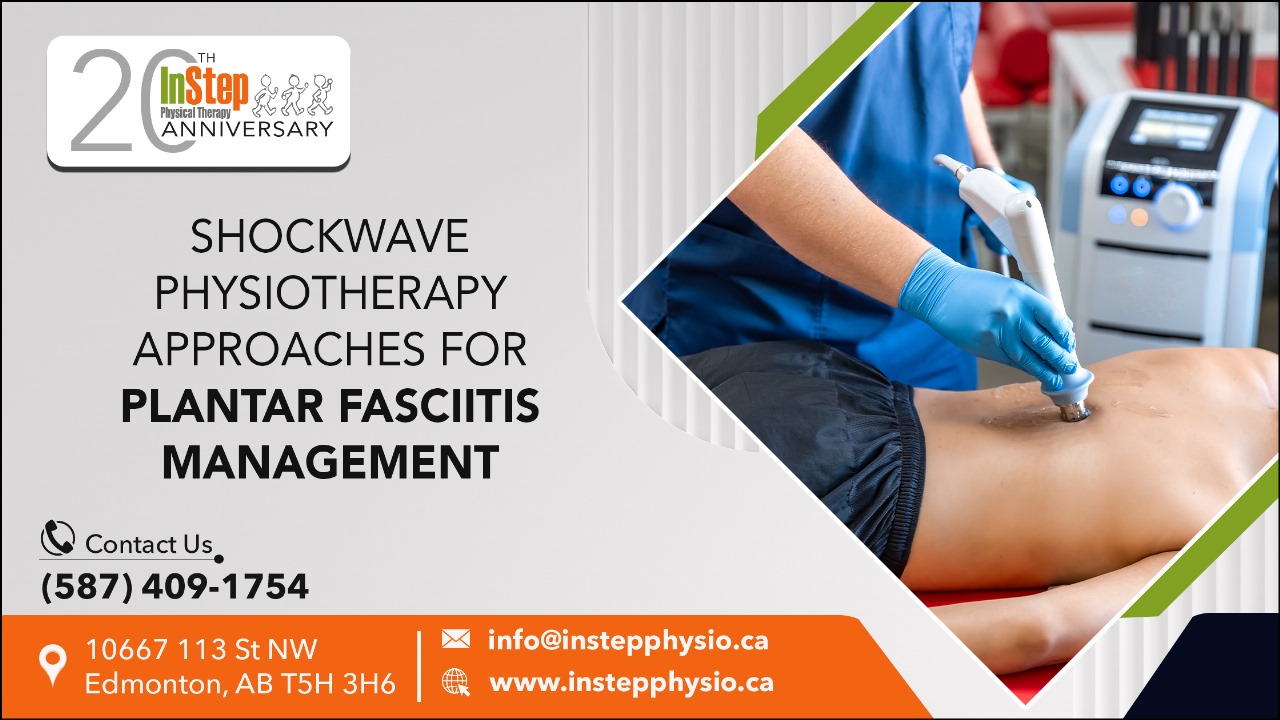Plantar fasciitis, characterized by stabbing heel pain, often results from strain and inflammation in the plantar fascia, the connective tissue stretching across the foot’s bottom. This discomfort can significantly impair mobility, making even regular walks a challenge. At In Step Physical Therapy Edmonton, cutting-edge shockwave therapy is employed as a key strategy in managing this debilitating condition. This article explores how shockwave therapy provides relief and promotes healing for those suffering from plantar fasciitis.
The Mechanism of Shockwave Therapy
Shockwave therapy employs acoustic waves that carry energy to targeted tissue areas within the body. For individuals grappling with plantar fasciitis in Edmonton, this state-of-the-art therapy facilitates the healing of the inflamed plantar fascia by:
- Stimulating blood flow to enhance tissue repair and cell growth.
- Breaking down accumulated calcium deposits that may contribute to pain.
- Encouraging collagen production, which is crucial for tissue repair.
Shockwave Therapy: A Non-Invasive Solution
Among the most significant advantages of shockwave therapy is its non-invasive nature. Patients looking for alternatives to surgical intervention find shockwave therapy a viable option. This innovative approach accelerates the recovery process without the downtime and risks associated with surgery.
Customized Treatment Plans for Plantar Fasciitis
Every case of plantar fasciitis is unique. Therefore, physiotherapists in Edmonton tailor shockwave treatment plans to individual needs. A comprehensive assessment precedes the therapy, ensuring the intensity and frequency of shockwaves are optimized for each patient’s specific condition.
Multifaceted Benefits of Shockwave Therapy in Physiotherapy Treatment
1. Pain Reduction
Shockwave therapy is known to help reduce pain associated with chronic conditions by inhibiting pain receptors and decreasing nerve sensitivity.
2. Tissue Healing
It promotes tissue regeneration by enhancing blood circulation, which is crucial for the repair of tendons, muscles, and ligaments.
3. Breakdown of Calcifications
The therapy can break down calcifications and fibrotic tissue commonly found in chronic inflammatory conditions, facilitating recovery.
4. Enhanced Mobility
By diminishing pain and inflammation, shockwave therapy can lead to improved joint mobility and function.
5. Muscle Tone and Spasticity
It can help reduce muscle tone and spasticity, which is beneficial for patients with neurological conditions or those recovering from injury.
6. Myofascial Trigger Points
The therapy can deactivate trigger points that contribute to muscle pain and stiffness.
7. Stress Fractures
Shockwave therapy can accelerate the healing of stress fractures by stimulating osteoblastic activity, which is critical for bone healing.
8. Scar Tissue Manipulation
The therapy can be used to break down scar tissue, improving elasticity and range of motion in the affected area.
9. Cellulite Reduction
While not a musculoskeletal condition, shockwave therapy has also been used in aesthetic medicine to reduce the appearance of cellulite.
Combining Shockwave Therapy with Conventional Treatments
While shockwave therapy is potent, combining it with traditional physiotherapy techniques can enhance its effectiveness. Such an integrative approach may include:
- Stretching exercises to enhance flexibility in the plantar fascia and Achilles tendon.
- Strengthening exercises to bolster foot and lower leg muscles, providing better support to the arch.
- Advice on proper footwear to reduce strain on the plantar fascia.
Other Conditions Treated With Shockwave Therapy
Tendonitis
Conditions like Achilles tendonitis and lateral epicondylitis (tennis elbow) respond well to shockwave therapy by promoting collagen production and tendon repair.
Non-Healing Ulcers
Shockwave therapy has been used to stimulate healing in chronic, non-healing ulcers, particularly in diabetic foot ulcers.
Osteoarthritis
For patients with osteoarthritis, shockwave therapy can help alleviate pain and thereby improve overall quality of life by restoring function.
Jumper’s Knee
Also known as patellar tendonitis, shockwave therapy can be beneficial in managing knee pain and promoting tendon repair.
Erectile Dysfunction
Recent applications have extended to vascular-related conditions such as erectile dysfunction, where shockwave therapy can improve blood flow.
Shoulder Injuries
Conditions like calcific tendinitis of the rotator cuff and frozen shoulder (adhesive capsulitis) can benefit from shockwave therapy by breaking down calcific deposits and improving shoulder mobility.
The Road to Recovery: What to Expect
The road to recovery with shockwave therapy is usually straightforward. Most patients experience relief after just a few sessions. The procedure is quick, with each session typically lasting no more than 15-20 minutes. Patients can return to their routine immediately, making it a convenient option for those with busy lifestyles.
The Transformative Impact of Shockwave Therapy in Musculoskeletal Treatment
In the realm of physiotherapy, shockwave therapy emerges as a beacon of innovation, offering a potent, non-invasive solution for a spectrum of musculoskeletal disorders. This therapeutic approach, harnessed by In Step Physical Therapy Edmonton, signifies a profound advancement in the management and alleviation of chronic pain.
The versatility of shockwave therapy in Edmonton lies in its ability to target and treat conditions from plantar fasciitis to stubborn tendinopathies, offering relief to those who may have struggled with persistent discomfort. Its application extends to a variety of demographics, from athletes combating sports injuries to individuals with degenerative conditions like osteoarthritis.
